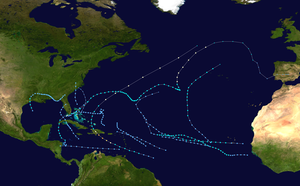| Timeline of the 1987 Atlantic hurricane season | |||||
|---|---|---|---|---|---|
 Season summary map | |||||
| Season boundaries | |||||
| First system formed | May 24, 1987 | ||||
| Last system dissipated | November 4, 1987 | ||||
| Strongest system | |||||
| Name | Emily | ||||
| Maximum winds | 125 mph (205 km/h) (1-minute sustained) | ||||
| Lowest pressure | 958 mbar (hPa; 28.29 inHg) | ||||
| Longest lasting system | |||||
| Name | Arlene | ||||
| Duration | 12.25 days | ||||
| |||||
The 1987 Atlantic hurricane season was an event in the annual Atlantic hurricane season in the north Atlantic Ocean. It was a below-average season, having fewer named storms than in a normal year,[1][2] that resulted in little impact throughout the Atlantic basin; the United States recorded no hurricane-related fatalities, making the 1987 season the fourth to do so since 1976. The season officially began on June 1, 1987 and ended November 30, 1987. These dates, adopted by convention, historically describe the period in each year when most systems form.[3] Even so, a pre-season storm, Tropical Depression One, led to the season's starting on May 25. Storm activity ended several weeks early; the final storm of the season, Tropical Depression Fourteen, dissipated on November 4.[1]
The season had fourteen tropical depressions, of which seven intensified into tropical storms—an average season has ten tropical storms[2]—three became hurricanes and one, Emily, became a major hurricane.[nb 1] The inactivity throughout the basin was linked to persistent, strong vertical wind shear; most of the season's storms were unable to intensify due to the shear, resulting in a low number of named storms and hurricanes.[1] The two most notable storms of the season were Hurricanes Arlene and Emily. Hurricane Arlene spent roughly 14.5 days as a tropical storm before intensifying into a hurricane, the longest span between these intensities on record.[4][nb 2] Hurricane Emily was the only major hurricane of the season; its wind speeds peaked at 125 miles per hour (201 km/h) before impacting the Dominican Republic. Three fatalities occurred in the Dominican Republic because of the storm and damages were estimated up to $80.3 million (1987 USD).[1][5][6][7]
This timeline documents tropical cyclone formations, strengthening, weakening, landfalls, extratropical transitions, and dissipations during the season. It includes information that was not released throughout the season, meaning that data from post-storm reviews by the National Hurricane Center, such as a storm that was not initially warned upon, has been included.
By convention, meteorologists one time zone when issuing forecasts and making observations: Coordinated Universal Time (UTC), and also use the 24-hour clock (where 00:00 = midnight UTC).[8] In this time line, all information is listed by UTC first with the respective local time included in parentheses.
- ^ a b c d Robert A. Case and Harold P. Gerrish (April 1988). "Atlantic Hurricane Season of 1987" (PDF). Monthly Weather Review. 116 (4): 939–949. Bibcode:1988MWRv..116..939C. doi:10.1175/1520-0493(1988)116<0939:AHSO>2.0.CO;2. Retrieved July 1, 2009.
- ^ a b National Hurricane Center (June 5, 2009). "Tropical Cyclone Climatology". National Oceanic and Atmospheric Administration. Archived from the original on May 28, 2007. Retrieved October 10, 2009.
- ^ Dorst, Neal (June 1, 2018). "Hurricane Season Information". Frequently Asked Questions About Hurricanes. Miami, Florida: NOAA Atlantic Oceanographic and Meteorological Laboratory. Retrieved June 29, 2020.
- ^ "Atlantic hurricane best track (HURDAT version 2)" (Database). United States National Hurricane Center. April 5, 2023. Retrieved July 9, 2024.
 This article incorporates text from this source, which is in the public domain.
This article incorporates text from this source, which is in the public domain.
- ^ Harold P. Gerrish (November 12, 1987). "Hurricane Emily Preliminary Report: Page Four". National Hurricane Center. Retrieved July 1, 2009.
- ^ Nicholas DeGraff (August 25, 1999). "Natural Hazards and Disasters: Landslides in St. Lucia". University of California, Santa Cruz. Archived from the original on March 9, 2016. Retrieved July 1, 2009.
- ^ "The Federal Reserve Bank of Minneapolis". The Federal Reserve Bank of Minneapolis. 2009. Retrieved July 20, 2009.
- ^ "Understanding the Date/Time Stamps". miami, Florida: NOAA National Hurricane Center. Retrieved July 10, 2020.
Cite error: There are <ref group=nb> tags on this page, but the references will not show without a {{reflist|group=nb}} template (see the help page).